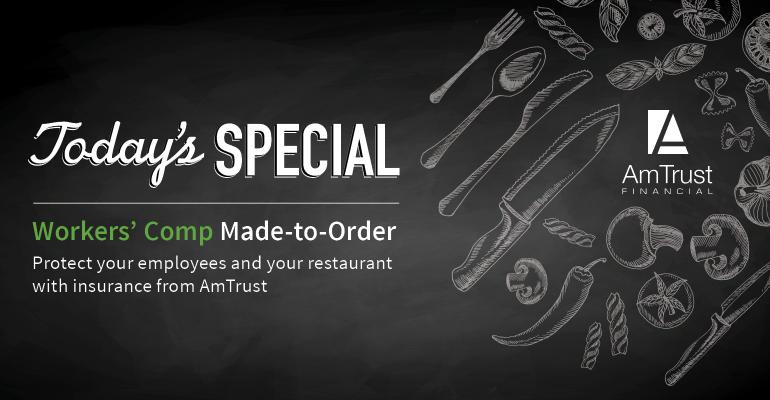Sponsored by AmTrust Financial
No matter what type of restaurant you run, whether it’s a four-star dining establishment or a fast casual atmosphere, your employees face a variety of hazards that could lead to potential accidents and injuries. Some of the most common injuries for restaurant workers include:
- Cuts, punctures and scrapes
- Burns from hot surface or oil
- Muscle strains and sprains from either slips and falls, repetitive motions, standing in the same place for long periods or improperly lifting heavy objects
Let’s take a closer look at some best practices you can implement to help improve the safety of restaurant workers, from the staff at the front desk to those in the back of the house.
Maintain the cleanliness of your floors
Slips and falls account for a significant amount of workplace accidents and injuries, and wet or slippery floors are often the culprit. Clean up any spills immediately after they occur and set a schedule for periodic deep cleaning. Use non-skid rubber mats in areas more prone to accidents, such as around the sinks, preparation and beverage stations and doorways. Keep paths clear at all times, moving items like cords, buckets, boxes, hoses, extra chairs, garbage cans and other possible obstacles tucked neatly away when not in use. Restaurant staff moves quickly, often carrying trays of food or drinks that could obstruct their line of sight, so anything in their path could easily cause them to trip and injure themselves. Though reported less frequently, slips and falls result in higher injury payouts, costing 4.5 times more than cuts, according to an AmTrust report that analyzed five years of workers’ compensation restaurant claims data.
Spread out repetitive tasks among employees
Monotonous movements like chopping and stirring, or even standing in one position for long lengths of time, can strain muscle groups and lead to fatigue or soreness. Employees should be required to take breaks from repetitive tasks and encouraged to stretch their muscles regularly to get relief. Also, consider adding ergonomic workstations to help reduce discomfort.
Train employees on knife safety
Employees required to use sharp knives should understand basic knife safety techniques. For instance, keeping the digits of the hand not holding the knife tucked in to keep them out of the way. Utilize a stable cutting board or another solid surface and cut away from the body, never touching the sharp edge of the knife itself. Keep knives stored properly when not in use, not simply tossed into a sink full of dirty dishes between uses, and never use them for anything but food preparation tasks. Protective cut gloves can be provided to staff using knives or slicing equipment to keep them even safer from a cut or puncture wound. Cuts and punctures make up about a third of workers’ compensation claims submitted to AmTrust, making it the most common injury.
Teach proper lifting and carrying methods
Employees should understand how to lift heavy objects without straining themselves. For example, lifting items by bending at the knees, not from the back. Heavy, awkward items should be carried by keeping the heaviest part closest to the body. Objects that weigh 50 pounds or more should require two people to lift and carry it or utilize material handling devices like handtrucks and dollies. Muscle strains from lifting result, on average, in the most missed days of work for employees (35 days), according to AmTrust’s report.
Practice safety around hot surfaces
According to the Burn Foundation, the restaurant and food service industry reports around 12,000 burns every year, the highest number of burns of any employment sector. Employees should always use the right protective gear, like oven mitts or gloves, when lifting hot pots and pans. Using hand towels to lift these hot objects can easily lead to a loosened grip that can cause a serious burn. If workers use fryers or cook with hot oil, further protective gear like spatter shields or gauntlets can help keep arms safe from splashing oil. Additionally, always follow the proper procedures for deep fryers, like changing the oil frequently and not overfilling the fryer basket to avoid spillage.
Small Business Insurance Solutions from AmTrust Financial
When it comes to keeping the employees in your restaurant safe and protecting your business, you need an insurance carrier you can trust. AmTrust Financial is a leader in small business insurance, offering made-to-order workers’ compensation coverage and more. We also provide a variety of loss control services designed to reduce workplace accidents and injuries at your establishment. Learn more about loss control best practices for the restaurant industry, or contact us today to get a quote for your small business.


![[10194] NA Featured_1540x800px (L7).png](https://www.restaurant-hospitality.com/sites/restaurant-hospitality.com/files/styles/article_related_thumb_standard/public/10194%20NA%20Featured_1540x800px%20L7_0.png?itok=y-LA_8c5)

